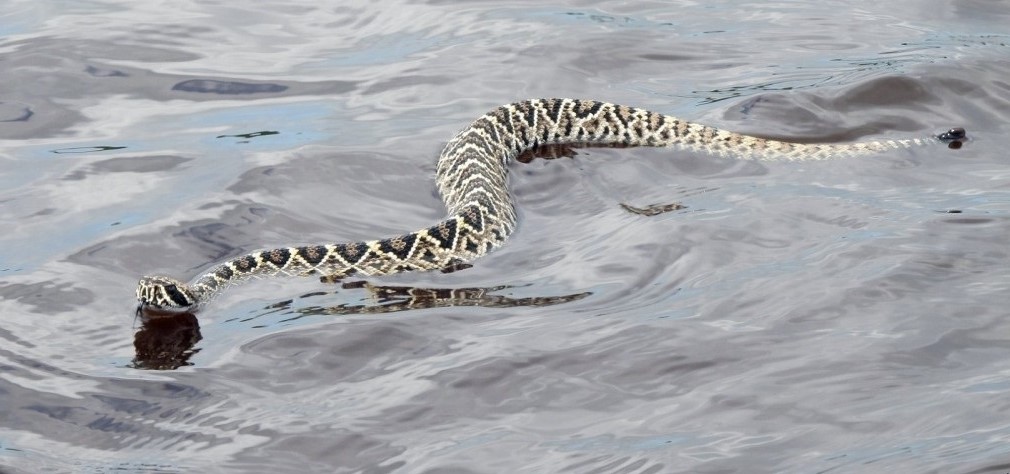In the mood to go on a short vacation on a hot summer day? You’re not the only one! Many animals take advantage of the season by cooling off in bodies of water. But can all animals swim? What about snakes? Do they take a dip to escape the heat?
There are many different types of snakes, and each type has its own set of abilities. For example, some snakes can climb trees while others can burrow underground. What about rattlesnakes? Can they swim?
What is a Rattlesnake?
Rattlesnakes are a type of snake that lives in North and South America. These reptiles get their name from the rattle on their tails, which they use to make a loud noise as a warning to predators or prey. They are venomous, meaning they have poison in their bites that can be harmful – even deadly – to humans and other animals.
Rattlesnakes use their venom to kill their prey before eating it. They are carnivores, which means they only feed on other animals. Some of the animals that these creatures like to feed on include rodents, rabbits, lizards, and birds.

So, Can a Rattlesnake Swim?
The short answer is yes, rattlesnakes can swim! And they’re actually pretty good at it. These reptiles are strong swimmers and can move quickly through the water. They often use their swimming ability to escape from predators or to hunt for prey.
Rattlesnakes don’t typically enjoy being in the water and will only go in if they have to. For example, if a rattlesnake is being chased by a predator, it may swim across a river to get away. Or, if it is hungry and there are no animals on land to eat, it may swim out to an island in search of food.
Rattlesnakes are not the only type of snake that can swim. In fact, most snakes generally swim quite well. Some that can swim include boa constrictors, water snakes, and sea snakes.

Do Rattlesnakes Go Near Water Sources?
All kinds of snakes will go near water from time to time. After all, many of the animals that rattlesnakes like to feed live near or in water.
Rattlesnakes will sometimes bask in the sun near water, which helps them regulate their body temperature. These snakes are ectotherms, meaning their body temperature depends on the temperature of their surroundings. When it’s cold out, they will move to a warm place and when it’s hot, they will move to a cool place – like near water.
Are Rattlesnakes Habitat Found Near Water?
Rattlesnakes live in a variety of habitats, including deserts, forests, and grasslands. They are often found near water, but not always in the water. In fact, most of them avoid getting into the water if they can help it!
They prefer to live or build their habitat on dry land, where they can find plenty of prey and basking spots. However, they also like to make their homes near water sources because it helps them regulate their body temperature.

What Attracts Rattlesnakes to Water?
There are a few things that can make a rattlesnake want to go near the water, even if it doesn’t want to swim. For example, if they are looking for food, they might go near the water because most of their prey will be there.
Rattlesnakes will sometimes be found near rivers, ponds, and lakes when they want to rehydrate. These snakes will soak up the sun and then drink the water that they need.
They can also cross small bodies of water when they are looking for a new place to live. Some, like the timber rattlesnake, will even build their dens near water sources. This helps them stay cool in the summer and warm in the winter.
Animals that Rattlesnakes Feed on Near Water
There are animals that are often on the menu for a rattlesnake. Some of them love to be near water sources such as:
- frogs
- aquatic insects.
- mice
- squirrels
- birds and their eggs
- small rabbits
- small lizards
Rattlesnakes will sometimes chase prey in the water. Timber rattlesnakes are an example of rattlesnakes that will often hunt near water sources. They will wait for their prey to come close to the water’s edge before they strike.
Which Types of Water do Rattlesnakes Prefer?
Rattlesnakes will often be found near still water sources such as ponds and lakes. Many people have their story of their first timber rattlesnake encounter being next to a lake.
They often stalk small animals in these areas. They seem to prefer these types of water sources because they offer more opportunities for prey and basking. However, they have also been known to swim in moving water such as rivers and streams. This is likely because they are looking for food or a new place to live.
What Does a Rattlesnake Do When it Swims?
Rattlesnakes use their long, muscular bodies to move through the water in a side-to-side motion. They glide through the water using their scales, which act like mini paddles. This helps them to move quickly and efficiently through the water. They will often swim with their head and neck held above the water so they can breathe.
The surface tension of the water also helps to support the snake’s body, which means they don’t have to use as much energy to stay afloat. This is why rattlesnakes can swim for long periods of time without getting tired.
They will swim in ponds, lakes, and rivers – anywhere there is water to help them beat the heat! You can often find them basking on the banks of these water sources, or even in trees near the water.
Can Rattlesnakes Swim Underwater?
Rattlesnakes are known to be good swimmers, but can they swim underwater? The answer is yes! Rattlesnake swimming underwater has been observed in both the wild and in captivity.
These reptiles can hold their breath for up to 45 minutes when they are swimming underwater. This is helpful because it allows them to stay hidden from prey and predators.
Can Rattlesnakes Bite in Water?
For a lot of people, a swimming snake may be the stuff of nightmares. But can a rattlesnake bite you when it’s in the water?
Rattlesnakes are used to striking while in a coiled position on the ground, so, they’ll have a harder time striking while in the water. However, that doesn’t mean they can’t do it. If a rattlesnake feels threatened while in the water, it will still try to bite.
Do Rattlesnakes Drink Water?
Just like all other animals, rattlesnakes need water to survive. They will drink water when they are thirsty and they will often be found near water sources. These reptiles drink differently from other animals though, and they can’t just stick their tongue in the water to take a sip. Instead, they use capillary action to draw the water into their mouths.
Capillary action is when a liquid is drawn up a small tube or space by molecular attraction. This is how a rattlesnake is able to get water into its mouth without using its tongue!
Conclusion
Water is an essential part of a rattlesnake’s life, and they have no qualms about swimming in it – even if it’s just to cool down. They are good swimmers and can hold their breath for long periods of time.
They are pretty buoyant too, thanks to their scales and the surface tension of water. So, if you’re ever wondering if rattlesnakes can swim… the answer is a resounding yes! So, always be mindful of your surroundings when you’re near water – you never know who (or what) might be swimming with you. If you need a rattlesnake removed from your property, don’t hesitate to call AAAC Wildlife Removal!
Originally published on https://aaacwildliferemoval.com/blog/snakes/do-rattlesnakes-swim/




